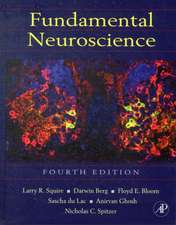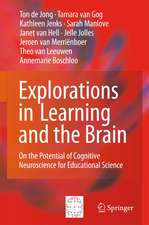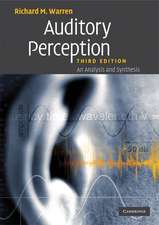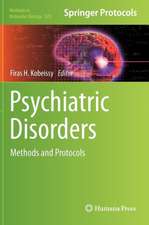Fertilization
Autor Daniel M. Hardy, D. L. Garbersen Limba Engleză Hardback – 12 dec 2001
- Provides in-depth reviews of individual research topics
- Emphasizes key concepts and significance of findings to other fields
- Broadly covers the many molecular and cellular events of animal fertilization
- Includes a section on unique problems and potential applications of fertilization research
- Identifies essential questions to be answered by future research
Preț: 1329.78 lei
Preț vechi: 1399.78 lei
-5% Nou
Puncte Express: 1995
Preț estimativ în valută:
254.46€ • 272.10$ • 212.16£
254.46€ • 272.10$ • 212.16£
Carte tipărită la comandă
Livrare economică 17 aprilie-01 mai
Preluare comenzi: 021 569.72.76
Specificații
ISBN-13: 9780123116291
ISBN-10: 0123116295
Pagini: 448
Dimensiuni: 152 x 229 x 21 mm
Greutate: 0.69 kg
Ediția:New.
Editura: ELSEVIER SCIENCE
ISBN-10: 0123116295
Pagini: 448
Dimensiuni: 152 x 229 x 21 mm
Greutate: 0.69 kg
Ediția:New.
Editura: ELSEVIER SCIENCE
Public țintă
Reproductive endocrinologists, biotechnology industry, gynaecologists, infertility/fertility/contraception specialistsCuprins
Contributors
Preface
Acknowledgments
Section I Fertilization Events
1 Gamete Transport
I. Introduction
II. Sperm Transport
III. Oocyte Transport
IV. A Model for Gamete Transport
References
2 Sperm Motility ActIVation and Chemoattraction
I. Introduction
II. Assays
III. Motility Acquisition
IV. Motility ActIVation
V. Motility Modulation in the Female ReproductIVe Tract
VI. Egg-associated Motility Stimulation
VII. Chemoattraction
VIII. Concluding Remarks
References
3 Capacitation
I. Introduction
II. initiation, Propagation, and Termination of Capacitation
III. Molecular Mechanism of Capacitation
IV. Physiological Mechanism and Role of Capacitation
V Conclusions
References
4 Function of the Egg's Extracellular Matrix
I. Introduction
II. The Cumulus Oophorus
III. The Zona Pellucida
IV. Future Directions
References
5 Sperm Adhesion to the Extracellular Matrix of the Egg
I. Introduction
II. Basic Biology of Sperm-Eem Adhesion
III. Identification of Eem Adhesion Molecules
IV. Future Prospects and Directions
References
6 Signal Transduction Mechanisms Regulating Sperm Acrosomal Exocytosis
I. Introduction
II. Biogenesis and Morphology of the Acrosome
III. Biological Significance of Acrosomal Exocytosis
IV. Physiological Site of Acrosomal Exocytosis
V. The Zona Pellucida and Progesterone as Physiological Inducers of Acrosomal Exocytosis
VI. Sperm-associated Receptor/Binding Proteins for the Zona Pellucida and Progesterone
VII. Signal Transduction Mechanisms Mediating the Effects of the Zona Pellucida and Progesterone
References
7 Regulation of Sperm Lon Currents
I. Importance of Ion Channels
II. Sperm Ion Transport and EnVIronmental Sensing
III. Modulation of Sperm Ion Transport by Diffusible Egg Components
IV. Modulation of Sperm Ion Transport During the Acrosome Reaction
V. Spermatogenic Cells, A New Tool To Study Sperm Ion Channels
VI. Concluding Remarks
References
8 Function of the Sperm Acrosome
I. Introduction
II. The Prevailing View: the Acrosome Reaction Model
III. An AlternatIVe Paradigm: the Acrosomal Exocytosis Model
IV. Other Considerations of Acrosomal Proteins
V. Future Directions
VI. Summary
References
9 Gamete Fusion in Mammals
I. Introduction
II. Specificity of Gamete Fusion
III. A Hypothetical Pathway Leading to Sperm-Egg Fusion
IV. Sperm and Egg Surface Proteins Involved in Gamete Binding and Fusion
V. Hypothetical Steps After Binding and Before Fusion
VI. Sperm Tail Stiffening
VII. Fusion in Other Systems
VIII. Prospectus
References
10 Membrane Events of Egg Activation
I. Introduction
II. Ca2+ Waves and Oscillations At Fertilization
III. Electrical Events and Fertilization
IV. The Latent Period of Fertilization 327
V. Signaling Molecules and Mechanisms Leading To Ca2+ Release
VI. Sperm as a Ca2+ Conduit
VII. Sperm Contact as the Signal
VIII. The Sperm Content Hypothesis
IX. Conclusions
References
Section II Unique Problems and Applications
11 Molecular Genetics of Fertilization
I. Introduction
II. Gametes Have Unusual Characteristics
III. Genetic Model Systems
References
12 Gamete Immunobiology
I. Introduction
II. Fetal and Neonatal Germ Cells
III. The Developing Immune System
IV. Immune Response To Gametes in the Fetal, Neonatal, and Prepubertal Stages
V. Immune Response To Gametes in the Adult
VI. Immune Response To Male Gametes in the Adult Female
VII. Concluding Remarks
References
13 Fertilization Biophysics
I. Introduction
II. Sperm as Force-Generating Machines
III. Tethering Sperm
IV. Sperm Capture By Eggs
V. Sperm Penetration of Egg Coats
VI. The Transition From Sperm Adhesion To Penetration of the Zona Pellucida
VII. Summary
References
14 Applications of Fertility Regulation for the Management of Wild and Domestic Species
I. Introduction
II. Case Studies On Wildlife Management
III. Fertility Control: Targets and Immunological Intervention
IV. Reproductive Tract Immune Responses
V. Bait DelIVery of An ImmunocontraceptIVe Vaccine
VI. Concluding Remarks
References
Index











